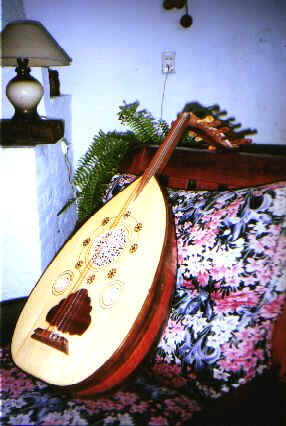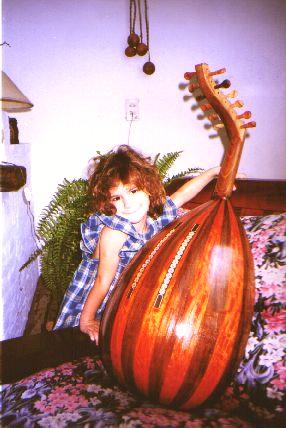This homepage will try to introduce you into the fascinating world of "OUDS", or Arabic lutes. Oud is the first member of the lute family, a complex stringed-instruments group whose more important "milestones" are two: the oud and the more known European lute, a later modification of the first one.
Hey! Here's a photo of me playing my Syrian oud. And here you can download a brief mp3 file to hear its sound.
Oud was developed about 500 aC... a millenium and a half ago! into the Arabic world. Originally designed with four strings, tuned CGDA (from bass to high), quickly they were inverted to ADGC. It remained relatively unchanged until the 8th century, when Ziryab added a fifth bass string tuned G. As you can see on the photo above, almost all strings are double ones. Then, it's useful to speak about "courses", this means a single or double string, without distinction. On the 15th century the oud falls slowly into forgetfulness, to reach a renewed interest on the last decades. Today ouds have generally a sixth single-stringed bass course, tuned D; then the 6-course oud tuned DGADGC has became almost a standard into the Arabic world (and beyond).
It seems that best ouds are from Damascus (Syria) and El Cairo (Egypt). Egyptian instruments are maybe better-looking ones, with their nice and complex ornamental pattern, but they are heavier than other ouds and not so suitable for playing as Syrians, for instance. Another gross topic that can help you to recognize a good oud for playing purposes, is its weight. Lighter oud, better sound is a general rule valid most times.
At this time, it's convenient to introduce a special member of the oud family: the Turkish oud, smaller than previously described and tuned a step above (EABEAD). Its sound is somewhat different, since it has more string tension, but the playing technique is similar in both cases. We must reserve the name "Arabic oud" to the other ouds mentioned before, like mine.
At the first look, you can see a couple of main differences between oud and lute: oud has three soundholes, a big central one and two smaller at each side of the first one. They're covered by an intrincated pattern disk named "rose" or "rosette", as lutes have. Also, oud is fretless! this is one of the problems to play it, but less difficult than it seems. Why oud is fretless? Arabic music has many scales with "microtones", this is, half flattened notes. At the first time you hear this music, you'll note some "detuned" notes but they aren't a bad oud play, but a microtonal scale playing! (If you want now to know more about maqamat or Arabic scales, press here).
The last thing of this part of the comments is that ouds must be played with a pick or "plectrum" (pl: plectra), made of horn or quill. There are plastic ones, but indeed the sound you get isn't so good as with conventional materials.
Here you have the same instrument showed before, 3/4 front and back:


You can appreciate, on the front photo, the soundboard design a little better than on the previous page. And on the back photo, you can see the ribs which make the bowl shape characteristic of these instruments (by the way, the girl is my younger daughter Barbara). Number of ribs clasically varies between 15 (like mine on the photo) and 21; as much as more ribs has an oud, more sharp and "metallic" it sounds, but maybe not more "authentical" as oud sound should be. I saw once a 13-rib oud here in Buenos Aires (the city where I live), made by an Arab luthier in this country, but I could'n appreciate its sound since it was in a dismal state of conservation!
The neck is generally smaller in long and width than European lutes. About the pegbox, it's curved and less angulated than its European counterpart. The correct tuning is a common problem regarding ouds, if you usually tune a mechanical-peg instrument like a guitar. Here the pegs are directly inserted into the pegbox (as in lutes), and this difficults a precise and smooth function. And you have another two problems: first, to coincide the pitch of both strings of a determined course, and then the correct tuning of all courses. Not an easy task to keep tuned an oud... If you experience problems regarding peg fixing (too loose, or too firm), get here some counsels to solve it.
Well, that's all regarding intro. Now you can check the stuff at left menu. Enjoy it! :-)
* * * * *